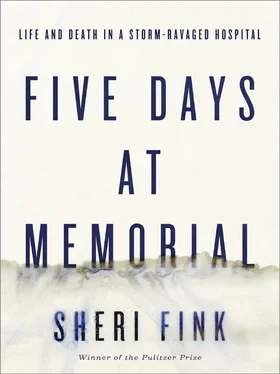St. Bernard had been slowly rebuilt after its surrender to spare New Orleans from the 1927 floods, but a series of subsequent calamities kept residents uneasy whenever weather disasters threatened. Many remembered the levee breaks, devastating flooding, and pumping-system failure that followed the Category Three Hurricane Betsy in 1965. St. Bernard residents had little faith that their officials or their levees would protect them.
It seemed wise to move the patients. Waiting for more certainty in the forecast would leave less time for action and make it harder to secure ambulances.
LifeCare had two other campuses in the area, including a leased space on a high floor of Memorial Medical Center that offered heady views of the city. This “hospital within a hospital” provided long-term treatment to very sick, often elderly and debilitated patients. Many of them were dependent on mechanical ventilators and underwent rehabilitation at LifeCare with the goal of breathing on their own and returning home or to nursing facilities; LifeCare was not a hospice. It had its own administrators, nurses, pharmacists, and supply chain. The staff still called the location “LifeCare Baptist” even though Tenet Healthcare Corporation had bought Baptist Hospital and changed its name to Memorial ten years earlier. Most of the St. Bernard patients, LifeCare’s leaders decided, would be moved there, and the remaining few to another nearby hospital.
Isbell called up the nurses she’d assigned to the “A” team at the start of hurricane season. They would join her at LifeCare Baptist during the storm and the “B” team would come to replace them after the storm had passed. The “A”s Isbell chose were strong nurses, team players, the ones she would want by her side at a stressful time. They had volunteered for the assignment. Working at an unfamiliar hospital would only add to the challenge.
Isbell had a passion for taking care of those whose long lists of medical problems put off some other health professionals. It took until nightfall to transfer nineteen of them to the Baptist campus. A twentieth died en route.
The patients traveled in clusters, up to four to an ambulance, because ambulances were already in short supply. They went with their own medicines, which the pharmacist prepared for them. Paraplegic patient Emmett Everett, who weighed 380 pounds, went from, and was resettled on, his own “Big Boy” bed.
The elevator doors opened on the seventh floor to face a wall adorned with the LifeCare philosophy.
LIFECARE
HOSPITAL
restoring hope
instilling desire
rebuilding confidence
LifeCare occupied three long hallways on the seventh floor of Memorial Medical Center—north, west, and south. The corridor to the east was devoted to Memorial’s marketing department. Isbell wove back and forth between patient rooms and nursing stations, ensuring her charges were registered and properly situated. When she exerted herself like this her round cheeks flushed a pretty pink. A phone call came in for her, but she was too busy to take it. Instead she passed a message to the caller, the daughter of one of her favorites, ninety-year-old Alice Hutzler. Hutzler had been wheeled into Room 7305, a spacious room on the west-side hallway with two televisions, a clock, and three roommates, including Rose Savoie, another elderly lady. Isbell knew Hutzler from repeated stays and fondly called her “Miss Alice.” To Isbell, Miss Alice looked perky, even with the stress of the move. “Perky” was relative. Hutzler suffered from heart disease, diabetes, dementia, and a stroke that had left her partially paralyzed. Now she was recovering from pneumonia and bedsores contracted at a nursing home. The fact that she would likely survive to make it back there meant, Isbell knew, a great deal to her attentive, loving family. Isbell passed a reassuring message to Hutzler’s daughter: “Tell her she’s here, and I’m going to take very good care of her.”
That night, LifeCare appeared to have made the right bet by moving patients out of the single-story hospital in St. Bernard Parish. The National Weather Service upgraded its hurricane watch for New Orleans to a warning delivered in an eerie all-caps bulletin, a format designed for the archaic Teletype: “THE BOTTOM LINE IS THAT KATRINA IS EXPECTED TO BE AN INTENSE AND DANGEROUS HURRICANE HEADING TOWARD THE NORTH CENTRAL GULF COAST… AND THIS HAS TO BE TAKEN VERY SERIOUSLY.” Heavy rains were expected to begin in twenty-four hours.

CHAPTER 3
DAY ONE
SUNDAY, AUGUST 28, 2005
ON SUNDAY MORNING, Katrina’s huge, Technicolor swirl filled the Gulf of Mexico on television screens throughout Memorial Medical Center. The Category Five storm packed the greatest intensity on the Saffir-Simpson scale. Dire forecasts shocked even the most seasoned hands. “MOST OF THE AREA WILL BE UNINHABITABLE FOR WEEKS… PERHAPS LONGER,” the National Weather Service’s New Orleans office warned. Katrina was “A MOST POWERFUL HURRICANE WITH UNPRECEDENTED STRENGTH,” certain to strike within twelve to twenty-four hours. “AT LEAST ONE HALF OF WELL CONSTRUCTED HOMES WILL HAVE ROOF AND WALL FAILURE. ALL GABLED ROOFS WILL FAIL… LEAVING THOSE HOMES SEVERELY DAMAGED OR DESTROYED. […] POWER OUTAGES WILL LAST FOR WEEKS… AS MOST POWER POLES WILL BE DOWN AND TRANSFORMERS DESTROYED. WATER SHORTAGES WILL MAKE HUMAN SUFFERING INCREDIBLE BY MODERN STANDARDS.”
Local leaders appeared on-screen to tell residents they needed to leave and leave now. The grim-faced president of a parish near New Orleans warned those who intended to stay to buy an ax, pick, or hammer so they could hack their way to their rooftops and not die in their attics like many Hurricane Betsy unfortunates had. He told them to “remember the old ways” and fill their upstairs bathtubs with water; after the storm that would be the only source for drinking, bathing, and flushing toilets.
The mayor of New Orleans, Ray Nagin, didn’t give his residents advice about the old ways. He ordered them to leave. At around ten a.m., he signed a mandatory, immediate evacuation order for the city. The order had been delayed by many precious hours, he would later admit, as his staff attempted to resolve logistical and legal questions, including whether he had the legal authority to issue it; as far as he knew, no previous New Orleans mayor had mandated an evacuation, although state law allowed the governor, parish presidents, and, by extension, him to do so.
Nagin read his order aloud to the public at a press conference with Louisiana governor Kathleen Babineaux Blanco. He stood in a white polo shirt before the inscrutable New Orleans city seal, on which a wriggling green form prowled beneath a figure that suggested the Roman sea god Neptune. An amphora under the crook of his arm was tipped, its contents gushing. “The storm surge most likely will topple our levee system,” Nagin warned. “We are facing a storm that most of us have feared.” Flooding, Blanco added, could reach fifteen to twenty feet.
While the mayor commanded everyone to leave, many didn’t have cars or other means to do so, and officials knew that the city’s plans to help transport them had significant holes, including a lack of sufficient drivers. Residents who could go on their own were already stuck in traffic on the interstate leading out of town. The Superdome, the giant stadium that hosted the New Orleans Saints football team, was designated as a “shelter of last resort.” New Orleanians who had no way to get out of the city could take a shuttle bus there. Mayor Nagin appealed to one population in particular. “If you have a medical condition, if you’re on dialysis or some other condition, we want you to expeditiously move to the Superdome,” he said. He didn’t mention what kind of help people could expect there.
Читать дальше













